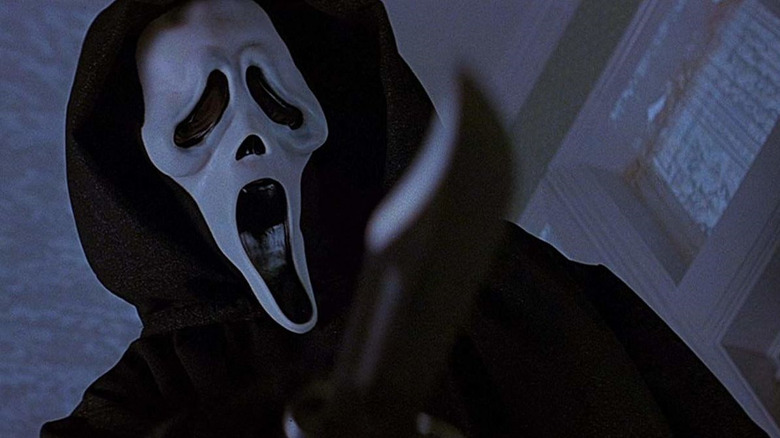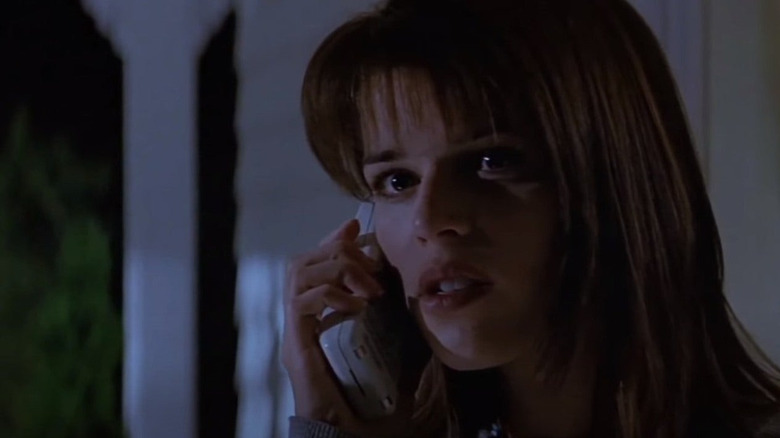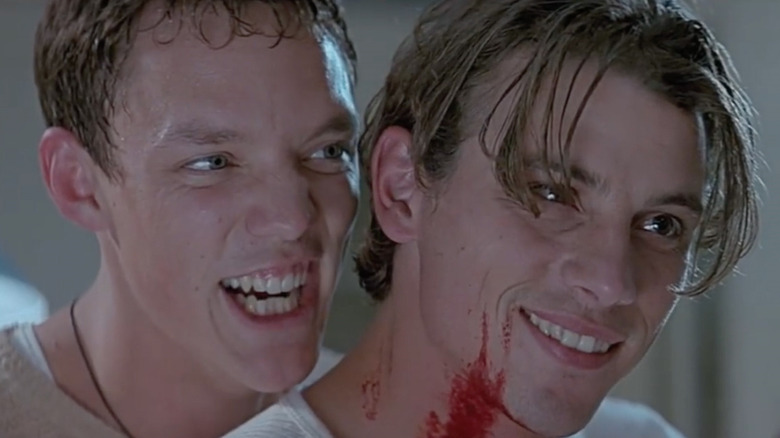The Ending Of The Original Scream Still Kicks Ass Decades Later
When Wes Craven's "Scream" dropped in December of 1996, there occurred a seismic shift in the horror genre. In a field of stale slasher franchises — the previous year saw the sixth entry in the "Halloween" film series and the fourth trip back to Texas chain saws — Kevin Williamson's sharp, cynical script breathed fresh life into a subgenre that had come a long way since Michael Myers broke out of Haddonfield Hospital in 1978. The film spawned a handful of sequels, and its latest, the terribly-titled "Scream" (2022), will release in theaters on January 14.
Much is made of the endings to the "Scream" films because the payoff is often big. The films function as both slashers and mysteries, with the killers' identity constantly in question amid red herrings. But all roads lead back to Sidney, so when the third act rolls around, the killer reveal also exposes a part of her past, her family's past, and the town's past all in one. Craven's original "Scream" stands above its sequels by way of being the first of the franchise, but its ending is also the most effective of the series. Let's unpack it.
Whodunit?
"Scream" (1996) concerns one Sidney Prescott, a student at Woodsboro High School grieving the death of her mother who was brutally raped and stabbed to death a year prior. A series of killings in Woodsboro coincide with horrible, taunting phone calls Sidney receives from the killer, who wears a hooded cloak and a Ghostface mask, hiding their identity. Sidney no longer knows who to trust between the cops, represented by Dewey Riley (David Arquette), the salacious media represented by Gale Weathers (Courteney Cox) that air everyone's dirty laundry and casts doubt on Sidney's memory, or Sidney's brooding boyfriend, Billy (Skeet Ulrich). There are plenty of suspects, but they all seem to have convenient alibis when the slicing and dicing happens.
The secret finally comes out during the remains of an after-curfew house party, when Billy is attacked by Ghostface but survives, tumbling down a staircase and coaxing a gun from a terrified Sidney. Billy straightens up, channels Eric Binford in "Fade to Black," and loses himself in the chasm between fiction and reality. He quotes the movie "Psycho" (arguably the first proper slasher), shoots Randy, and informs his girlfriend that he and his pal Stu (Matthew Lillard) have been working in cahoots to dispatch six victims — and they began with Sidney's mother a year ago.
The reason? A one-two punch.
Billy cites Sidney's mother as the reason he snapped, blaming her homewrecking affair with his father for the disintegration of his family. Stu's given motive was a cheeky "peer pressure." In fact, the pair created an entire narrative for themselves, one that condemns Sidney for her mother's sins and brings them fame (they give each other flesh wounds so they can present themselves as survivors, framing Sidney's father for the murders), punishing a town they hate in the process.
Not In My Movie
All of the talk about horror rules in "Scream" have their own payoff, and not in rapid-fire movie quotes. Don't have sex, don't drink or do drugs, don't say you'll be right back ... these can ensure survival, says Randy. But just as the film entire breaks new ground on an old subgenre, Sidney refuses to abide by Billy and Stu's narrative. She gives the deadly duo a taste of their own medicine, putting on the mask herself and calling Billy using the voice modulator used to terrorize her so many times earlier. She saves her father and drops a tv on Stu's head before Gale shoots Billy, seemingly killing him.
It's here that Randy reminds everyone of another guideline in horror movies; it's the part when Jason Voorhees rises out of the lake to grab Alice, and when Carrie's bloodied hand reaches from beyond her grave to grasp Sue Snell. It's the moment "when the supposedly dead killer comes back to life for one last scare."
Billy does get a jump scare in, leaping up from the ground and reaching towards the survivors, but doesn't get any further before Sidney puts a bullet in his forehead. As the smoke curls from her dead boyfriend's wound, she quips, "Not in my movie." A cop doesn't save the day and no curse is lifted, but by the time the sun comes up on the town of Woodsboro, Sidney Prescott has taken control of a narrative set forth for her (not as a random victim but a target and pariah), confronted her own deep-seated issues, and emerged as the victor without having to marry someone or have a baby to achieve spiritual wholeness. I don't think you guys get how rare this was (and still is) in a slasher.
Infusing a woman's narrative into a survivor-focused series worked so well for the film that writers stuck with it for every sequel; each successive killer has had a bone to pick with the Windsor College grad and on occasion (all but the third film, really) enlisted some film bro to do the heavy lifting. It remains to be seen whether the nouveau "Scream" follows suit, but if they do, you can bet that Sidney will always have the final say on her own story.


